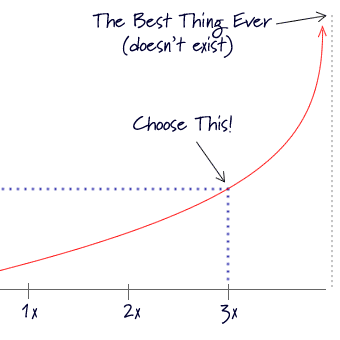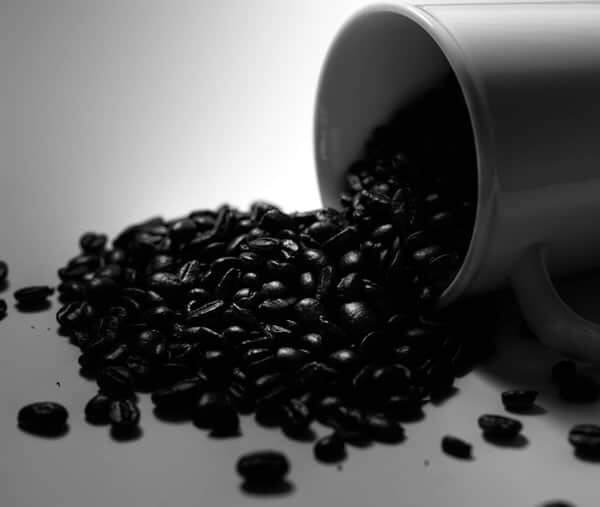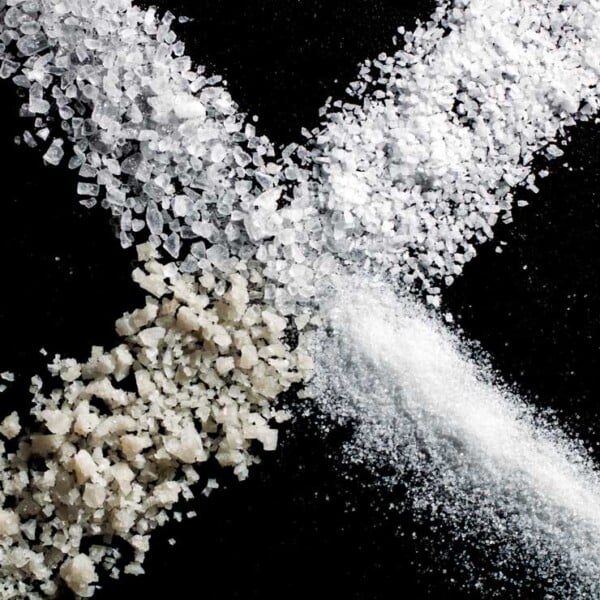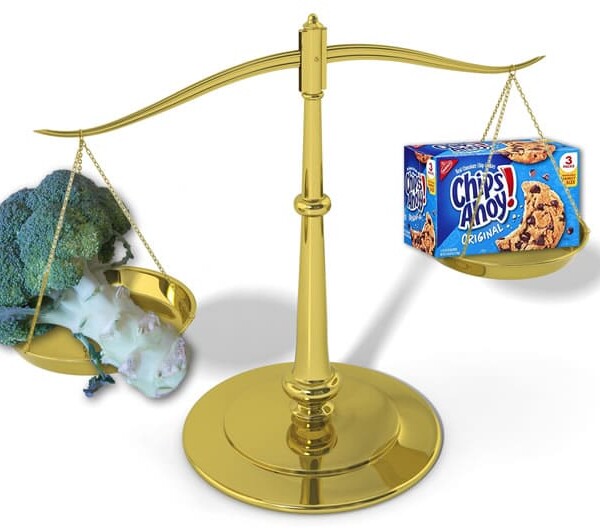There are no bad foods (and five more industry lies)
Apr 14, 2017, Updated Sep 26, 2018
Spin, Spin, Spin…
Over the past few years, I’ve been bumping into the same arguments over and over again about food and healthful eating. They are pervasive and persuasive, and pretty convincing if you aren’t willing to scratch below the surface. But if you really stop to think about them, they’re specious arguments. Next time you hear any of these food-related claims, take a moment and think about what’s really going on.

1. “There are No Bad Foods.”
According to the food industry, there are no such thing as bad-for-you foods, it’s just how much of them you eat.
Bullpoo! Of course there are unhealthful foods!
The easiest example to give is anything with man-made trans fats (which is anything with hydrogenated or partially-hydrogenated oil). There is no safe intake level of trans fats. Some other simple examples: Chocolate Cake or Potato Chips (they may be good for you psychologically, but not physically). Or how about soda, which has absolutely no redeeming nutritional value?
(Okay, if you want to split hairs: Yes, the sugar will give you energy, but there’s no other nutritional benefit whatsoever — and the negative effects of soda and other sugar-sweetened beverages [PDF] are well-documented and well-known.)
Last month there was a study published in the New England Journal of Medicine that drives home this point. They learned that — surprise, surprise — potato chips are bad for you, while fresh fruits and veggies are good for you. Dr. Mozaffarian, one of the study’s authors, was quoted in the New York Times: “There are good foods and bad foods, and the advice should be to eat the good foods more and the bad foods less.” He continued: “The notion that it’s O.K. to eat everything in moderation is just an excuse to eat whatever you want.”
Which brings us to my next point.
2. “Everything in Moderation.”
Okay, so there are bad-for-you foods. But taken in moderation, they’re okay, right? Well, yes. But watch out, it’s not that simple.
The definition of “moderation” is very different than what the food industry would have you believe. Purveyors of processed products lure you in with the notion that you can indulge a little each day and be just fine. In theory, that’s true. In practice, however, it rarely works out that way.
The 2005 USDA Guidelines used the term “discretionary calories,” defining them as the extra, nutritionally-devoid calories you could safely consume (around 150 to 300 each day, depending on overall caloric needs), after you’ve already satisfied the rest of your day’s nutritional requirements. The more recent 2010 “My Plate” guidelines use the term “empty calories” (a phrase, I’m pretty sure, that was actually coined by my mother). Same concept, but now with a more accurate name. (“Discretionary” doesn’t have quite the same negative connotation as “empty” — so I think this is an improvement on the USDA’s part).
So if — and only if — you ate perfectly healthfully all day long (practically impossible), you could then indulge in just three Oreo Cookies or half an order of In-N-Out Fries, or one can of Coke. In reality though it just doesn’t work that way. Most of us sneak our empty calories into our mouths a little at a time, often without even realizing it (ketchup or mayonnaise on a sandwich, a teaspoon of sugar in our coffee, chips with our sandwich, Gatorade after a workout).
It’s not just the obvious, added bits, either. That 500-calorie bran muffin? Sure, 300 of those calories might come from good-for-you ingredients (like whole grains) — but the other 200 might come from discretionary/empty butter and sugar.
Those empty calories add up so quickly and easily that there’s actually no room left over for that cookie at the end of the day. As a result, a more appropriately reality is that most of us can indulge once a week, not once a day. Sure, have those Oreos, fries, or Coke. But do it once a week, not once a day, and when you do indulge, truly make it count. (Oh, and please make sure it’s just once a week — most of us underestimate how frequently we indulge! Don’t believe me? Keep a log.)
3. “Personal Responsibility.”
This is probably the most controversial of my pet peeves. I whole-heartedly believe that personal responsibility is incredibly important, and tops the list of improving one’s diet and health. You decide what you put in your mouth (or your kids’ mouths).
But that’s not the whole story.
There are dozens of factors that influence what you choose to eat. Taste is the primary factor, of course, and many people stop there (though if you’re reading this, you’re probably not one of those people). Food companies engineer their products in labs (not kitchens) to taste good, using the holy trinity of fat, sugar, and salt. Our brains are hard-wired to enjoy those three flavors/ingredients, and a good case can be made that they can actually be physically addictive. (For a terrific, and highly-readable, discussion of this particular topic, check out The End of Overeating by David Kessler.)
So when it comes to taste, we’re up against an industry that spends billions of dollars to formulate their products, taking advantage of our brain chemistry. It’s no secret, and it’s nothing new — but to imply that choosing what we eat is simply a matter of willpower, and nothing else, is a bit disingenuous.
So how about advertising? In 2010, Pepsico, the largest food and beverage company in the United States, spent $3.4 Billion on marketing and advertising.[1] That’s only about 10% of all food product advertising each year! Companies wouldn’t spend those incredible amounts of money unless, of course, advertising worked.
Other external factors come into play, as well. To name a few: Knowledge and education. Accurate information about what is actually in the food. Misleading or confusing labeling on packages (Nutritionism!). Cost, budget, and affordability. Availability and Food Deserts. Convenience. Time constraints. Peer pressure and social situations. Structural Racism (hat tip: Emily). (Want more? Check out this discussion on the Eating Rules Facebook Page).
I’ve said it before, and I”ll say it again: There needs to be a level playing field, and right now the odds are tipped far, far away from the consumer.
4. “Fruit Juice is Fruit.”
I can certainly understand why the food companies consider this lie to be true — it makes sugary beverages seem healthful, and that’s good for sales! Unfortunately, our government supports this ridiculous notion as well.
Fruit juice is essentially sugar-water –– with a few vitamins remaining. Whole fruit, however, still contains fiber and additional nutrients. This makes an enormous difference. Even if it’s the same amount of sugar, it’s absorbed by the body at a different rate. Additionally, real fruit will keep you feeling fuller longer, and therefore you’ll be likely to consume fewer overall calories that day.
One cup (8 ounces) of Apple Juice contains 114 calories, almost all of which come from 24 grams of sugar. It has 4% of your day’s Vitamin C, and 2% of your calcium and iron — numbers so low, they’re essentially irrelevant. Compare that to 8 ounces of Coke, which contains 100 calories and 27 grams of sugar. That means Coke and apple juice have a nearly identical nutritional profile.
In comparison, one large apple (3.25″ diameter) contains 116 calories, 23 grams of sugars, 17% of your Vitamin C, and 5 grams of fiber. That’s about 20% of your day’s fiber.
5. “Eating Healthfully is More Expensive.”
In the short term, if you consider only what you pay at the grocery store — this can certainly be true. Calorie-for-calorie, fresh fruits and vegetables cost up to ten times more than highly-processed food options.
Why? Because of government subsidies (which we desperately need to fix). Our government subsidizes corn production — the worst offender — at a rate of about $4 Billion a year. This artificially reduces the price, making corn an incredibly cheap commodity — which is then used for sweeteners, cheap livestock feed, and a whole host of other products. As David Sirota says in this must-read Salon piece, “That’s why McDonald’s can sell you a Big Mac, fries, and a Coke for around $5 — a bargain.”
In the long term, if you consider the cost savings of eating healthfully, then this industry lie becomes even more apparent. Obesity alone is estimated to have cost the United States $147 Billion in 2008. Obesity is just one part of it, of course. The USDA estimates that if we all ate more healthfully, we’d collectively save $71 Billion a year.
6. “Natural.”
I’ve written about this before, but it bears repeating. When it comes to food marketing, the term “Natural” is completely unregulated and is effectively meaningless.
I’ve seen “All Natural” claims on products that contain high fructose corn syrup, preservatives, artificial colors and flavors, and all sorts of other additives that I can’t even pronounce — none of which would I consider “natural.”
What’s most frustrating is that even though I know this to be true, I still catch myself falling for it every once in awhile. The word “natural” is so loaded, so powerful, that it’s hard, perhaps impossible, to break out of that mindset. The best solution? If you see “natural,” be incredibly skeptical.
And remember, if a product has to make health claims, it’s probably not a healthy product.
—
[1] “Snacks For a Fat Planet” by John Seabrook. The New Yorker, May 16, 2011.
Photo by Paco CT.





















It’s actually completely true — there are no bad foods only bad diets. This constant good food, bad food garbage only pushes us further into this perverse, unhealthy attitude toward food that is killing us both physically and psychologicaly as a nation. I’m sure you mean we’ll, but you are wrong.
Great Article. I am Crazy over coconut too. I use Coconut Oil, Cream (the meat), Vinegar, Aminos, Flour and Sugar. Coconut Secret is a good company for all but the Oil and Cream. Tropical Traditions and Wilderness family (both .com) are excellent places to get the Oil and Cream. Butter is good, from grass fed cows is best as stated above.
A Great Book to read is Getting Back to the Basics of Human Health by Mary Frost.
I agree with most of the above. Why was butter criticized? Healthy fats like pasture raised butter are essential. Weston Price suggested butter oil as a supplement. If you are afraid of butter go visit the Weston Price Foundation’s website, westonaprice.org .
Something else I wanted to add concerning the education angle. This past week I was at a bookstore (Yes, a real book store and not an e-book store LOL) I bought a Betty Crocker cookbook for the Holidays.. Betty Crocker used to be the GODDESS of the kitchen as far as granny was concerned. I get the book home and the majority of it speaks of using a bag of frozen corn, or refrigerated biscuits or frozen processed “shortcuts”. I was a bit flabbergasted that cookbooks have gotten to that point. What would my granny have said about that book? HA HA HA I wouldn’t want to know! Luckily I learned enough about cooking from granny so my family eats healthy and none of us have starved ..yet! What of those women who don’t know how to cook? How do they learn? Cookbooks such as the one I bought that… Read more »
I love this talk of butter =) My family is butter friendly… my family of 5 (3 teens!). I think butter is getting a bad rap here. Of course you don’t want to shove sticks of butter down your throat but organic butter is not bad for you! There are many vitamins that are fat soluble… “A” being the most well known. A little organic butter in the morning with toast (organic bread of course hehe) will help fill you up, absorb more of the nutrients and keep you full until lunch. The moderation rule is important when using any fat but as long as its organic without any of that processing crap it should not be considered empty calories =) I love coconut oil but would rather fresh organic butter over processed, refined coconut oil. As to your “all natural” argument… very VERY true. I would like to point… Read more »
I’m a lover of coconut oil and butter. I must say I am still floored that people consider butter “empty calories”. It is one of the healthiest fats you can have in your diet. Especially if it’s raw, pasture raised. Butter is made from all the rich cream from milk. So full of vitamins and nutrients the body needs. I make my own butter when I get the chance to and the buttermilk that comes off of it isn’t like the sour chemical laden stuff in the store. It’s so sweet and healthy.
We just got back from a 40 day sabbatical in Costa Rica. One of the many things that we noticed that was very different there is that their packaged and bottled foods don’t contain HFCS and also that while there are some overweight people, none were obese.
Then on our way home, we stopped in Orlando to take the kids to Disney. What did we notice there? HFCS abounds and well over 50% of the people we saw were morbidly obese.
I firmly believe that HFCS is far more deadly than even us skeptics believe.
Welcome back! Forty days in Costa Rica sounds a-mazing!
I’m not so convinced that if we took HFCS entirely out of our food supply and swapped it with Cane Sugar (or any other sugar for that matter) that we’d really be any better off. The bigger problem is the amount of sugar that’s in just about everything.
Having said that, I still won’t touch HFCS. 😉
Enjoyed this tremendously. Especially #4, which I touched on in my weekly What to Eat feature on “whole” food today. As for #1 – I agree that there are plenty of unhealthy foods, many marketed as health food that I personally wouldn’t touch with a ten-foot pole. BUT – you have to get people there. Demonizing certain foods (as so many diet plans love to do) can lead to the opposite result – people craving crap all the more. I find this a difficult line to toe with people – they’ve been trained to want rules, a plan to make their lives easier – but they need a deeper understanding as to why foods are unhealthy in order to want a true lifestyle change.
Excellent points. I’m a huge fan of the cheat meal for exactly those reasons. (I love French fries as much as the next guy, and I refuse to live without them, thankyouverymuch!)
I was going to say the same thing about the butter! 🙂
Even if butter is “closer to nature,” it unfortunately still qualifies as “empty calories.” It doesn’t have much in the way of beneficial nutrients. The USDA considers “solid fats” to be “empty calories,” but I’d be inclined instead to focus on those fats with “unhealthful fats” (mostly saturated animal fats), rather than the opposite, “beneficial fats,” (such as those found in nuts, avocados, etc.).
But as I said before, I still eat butter… just in small amounts. 🙂
Okay, that’s a very good post, but don’t be attacking my butter as an “empty calorie”, okay?
Discretionary calories…they get the best of me. No matter what I think or do, fact is, if I’m not writing everything down, I am getting too many of them.
Ha! For the record, I eat butter, too. I’ve decided that, for me, it’s better to have the “real” stuff than artificial margarine-like substitutes. Even so, butter is a very tiny portion of my fat intake… I try for healthier fats and oils whenever possible. (I’m totally enamored with coconut oil these days.)
You’re absolutely right about the discretionary calories adding up. I’ve been using LoseIt (www.loseit.com) again this month, since some bad habits were starting to creep in again. Tracking everything really does help!
I bought coconut oil because of all the recommendations. I haven’t opened it yet. Do you use it just like…oil?
Yep. Coconut Oil is solid at or below 76 degrees fahrenheit — so if you keep it in the pantry, it’ll generally be a soft solid. However, it melts as soon as you heat it up, so it can be easily used as a liquid oil.
I like it spread on toast in the morning (instead of butter). Because it has a very high smoke point, it’s good for stir-fry, baking, and other high-heat cooking (popcorn!) as well.
It does impart a coconut-flavor, so it’s definitely a matter of taste preference as well. I love it for making popcorn, but I’ve found that frying an egg in it is kinda funky… Best thing to do is experiment and see what you like.
(Remember, though, it’s still fat, so it’s high in calories. Best used sparingly…)
Yes, coconut oil is made of awesome (and makes a great moisturizer too). There are refined coconut oils, however, which don’t have a coconut flavor or smell to them. When refined, it does lose a bit of the nutritive value, but it’s still head and shoulders above most other fats. Just make sure that it comes from a good company, because the refined coconut oil is processed in different ways and from different parts of the coconut depending on the company, which affects taste as well as health value.
“Made of awesome” = I love it! I’m totally stealing that phrase.
Thanks for the important info on refined coconut oil!